Monday, June 12 / יום שני, 18 סיון
I got up at 07:00, and was refreshed. The residual stomach irritation had subsided. I equipped clothes for today, and headed to the dining room while Seth was still preparing. I got a croissant, dried fruit, חלבה (halvah), and watermelon: the lattermost was very tasty. I ate with the Corens and with Seth. At 08:15, we took off, and I saw Uncle Howard look like his usual self. Good!
On our drive to צפת (Safed), the geography of the area was mentioned. The climb from minus-200 metres to plus-800 metres was done via tortuous roads that didn’t agree with Janie (and maybe others too). There was no pulling over, though. Another interesting thing that Gili mentioned on this stretch was the Gerald Schroeder relativity: comparing the 6000 years of the Bible to the 16 billion years. I have heard this theory (hypothesis?) before, and it could have merit. Of course, my conviction is that the Bible was written in terms of human language and concepts, even if the deeper can’t be understood directly.
We entered צפת via David Elazar Street. He had significant influence for the IDF victory in the Six Day War, though like usual, the specific details have funneled into the Void of the Noachide Mind. In continuing the Six-Day War story, which has been ongoing from Gili, today marked the day of the cease-fire, fifty years ago. The theme of the trip has been subtle, but well executed in my opinion. As we drove up the tortuous and hilly city, the roads narrowed, and זכריה expertly navigated a very tight corner! We landed in the same parking lot that Shorashim Bus 247 landed, six years ago!
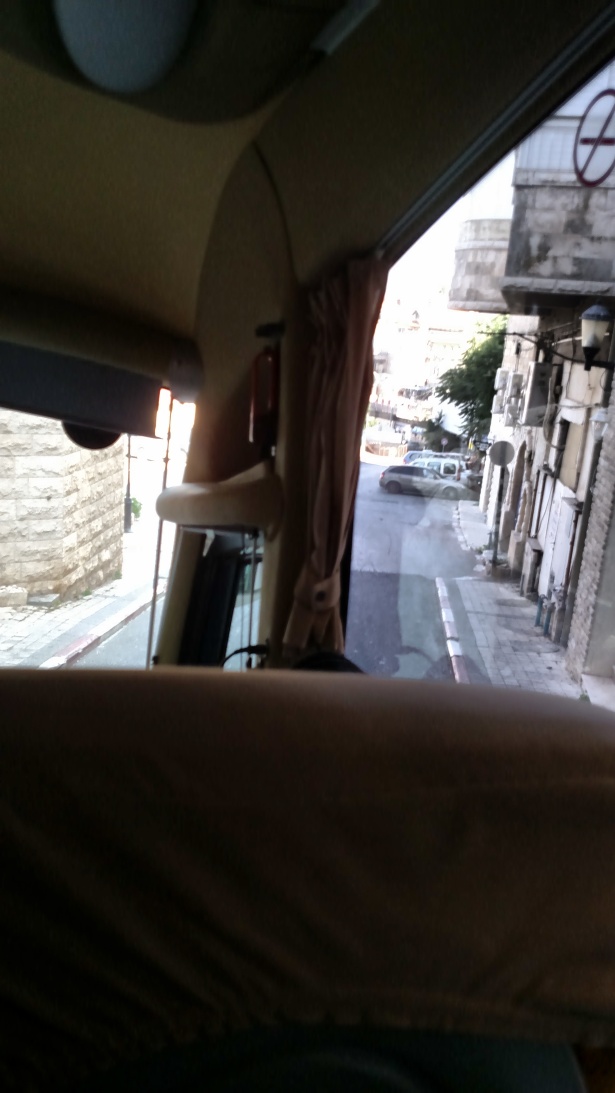
Tight… tight… GOT IT!
We had a few minutes at the Olive Tree Gallery, and as we left, we encountered the Bronkin Family from Omaha! You can’t take Nebraska out of Nebraskans! Then, Gili pulled out a map to explain our position: we are in the Biblical land of נפתלי (Naphtali). In more modern times, the city became a refuge for Spanish Jews after 1492.
Fast forwarding about 455 years, the British Mandate was about to end in 1947. The partition plan was accepted (despite not being liked) by the Jews, but Arabs said no to the partition and further attacked the Jews. In this city, as well as many other places, you can see bullet holes on buildings from that war. The Jews regained this city through a very unorthodox method. Despite being out-armed, out-strategized, and outnumbered, the Jews used loud booms of a certain cannon to frighten the Arabs into thinking that there was an impending mushroom cloud attack, as they fled.
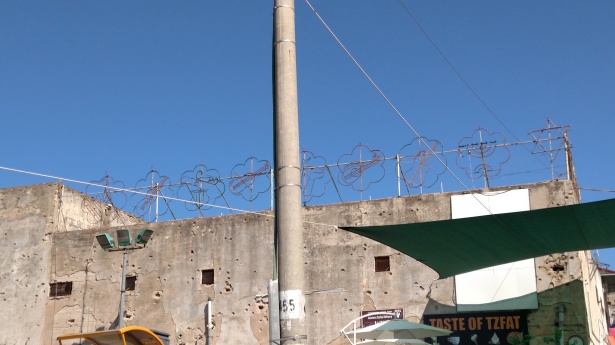
The buildings have bullet holes from 1947.
We continued to a special place: the Gallery of Mystical Art. YES! I managed to reintroduce myself to אברהם (Avraham)! He told his story of Jewish meditation and קבלה (Kabbalah / mysticism) as his manner of loving Judaism. Like last time, he went through descriptions of some of the pictures in his gallery, starting with the “yin/yang” picture with two ה letters. The top might ask “What can I get?” whereas the bottom might ask “What can I give?” This question brought some of the discussions from the weekend full-circle!
The picture with the downward pointing arrows in different colors is the one describing the 100 calls of the שופר (shofar) on ראש השנה (Rosh Hashanah), which was one of my favorites from 6 years ago. It reads from the bottom-up, and that is consistent with the idea of always creating self-improvement. It can represent a spiritual map to follow! A new piece of art based on the שופר was a drawing of the sound waves of the four different שופר calls, which obviously fascinated my physicist’s side. To continue the 6 Day War story, the שופר was blown along with the Special Announcement on Israeli radio. The other art was a colorful writing of אין עוד בלבדי (there is none besides me), which could refer to either השם (G-d) or to a person’s own name!
It becomes awesome to inject love into this world. You are going above and beyond if you can love another’s child as you would love your own. The epitome of life is to make goodness. Additionally, balances appear in many situations. Thankfulness can lead to truth, whereas complaints can bury you deeper in illusions. There is a lot of spiritual energy which can be used, and we can make it into love! Inspired by these words and holding enough money (in the sense of a debit card), I bought the artwork with the colorful triangles denoting the calls of the שופר. I also got a picture with אברהם: this was awwwwwwesome!
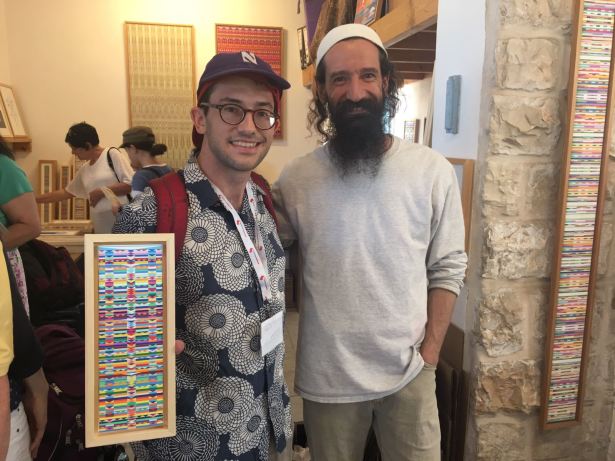
Noah and Avraham, the former posing with his new piece of art. Photo credit: Lori Feldman
After I left, I noticed most of the group sitting under fresh tree waiting for Number Zero. When he arrived, he mentioned all of the blue in צפת. This relates to the color פתיל תכילת. As we headed back toward the area where the bus was, we stopped at a Jewish Zodiac circle with the 12 months of the calendar, and the symbols thereof. I pointed at the סיון sector. Rising uphill to the “Pomegranet [sic] Juice” stand, we continued into the corridor with the pushy salespeople and emerged at the Rabbi Yose Caro Synagogue, which is an old Sephardic synagogue (I don’t think it’s in use anymore as an actual house of worship).
In Sephardi synagogues, the seating is all around the central בימה (bimah) instead of the Ashkenazi form of having the בימה at the front and all other seating behind. Additionally, the תורה (Torah) is read upright in its own case. There was no need for a מחיצה (mechitzah) in these synagogues, because there was a separate women’s room for prayer and study.
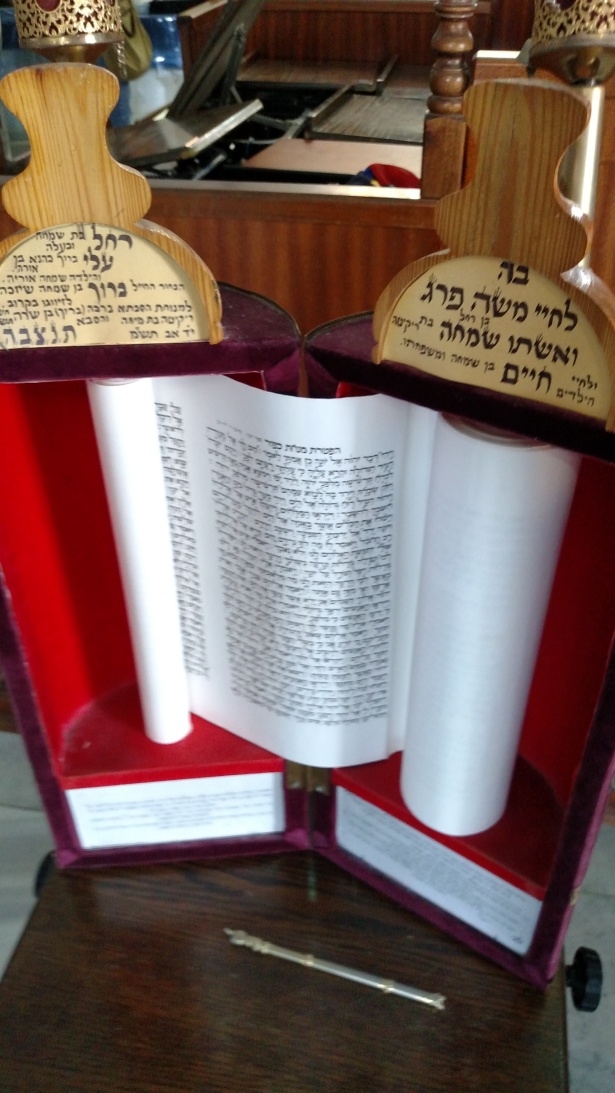
The Torah read upright. (Strangely, it’s on the Book of Jonah.)
This shul’s claim to fame was the birthplace of the שולחן ארוך (Shulchan Aruch) which was the first code of Jewish law within the borders of present-day Israel. Furthermore, Gili explained that the “four elements” each have an Israeli city. Air or Wind belongs to צפת. Fire belongs to ירושלים (Jerusalem). Water belongs to תיבריה (Tiberias), and Earth belongs to חברון (Hebron). Another thing: the city of צפת is prone to earthquakes. However, the southern walls of synagogues did not seem to be affected — the south walls are the closest walls to Jerusalem, and where the ארון הקודש (Holy Ark) would be. Divine protection or just coincidence, I don’t know. Nevertheless, it’s fascinating!
Before I left, I noticed that the scroll shown out for demonstration was opened to the book of Jonah. I didn’t expect that since the book of Jonah is not one of the Five Books of Moses. Leaving the shul, we continued northbound and stopped at the Fig Tree Courtyard. We saw the fig tree and the cistern (the latter was obscured by glass so that nobody could fall in), and then split to have a lunch/shopping break.
My first plan of action was to follow someone, and I went with Liz and Jay. We ascended stairs, and went through the Ari synagogue courtyard, and were shortly at Safed Candles. The Noah’s Ark is still there, and I noticed a chess set that I don’t think I saw six years ago. As we exited, a bunch of our group entered, and encouraged us to look again. Noah’s Ark had cartoons like Tom and Jerry, Timon and Pumbaa, and Pinky and the Brain. The chess set contained well-known Jewish people or buildings, and one of them was שלמה כרלבך (Shlomo Carlebach)!
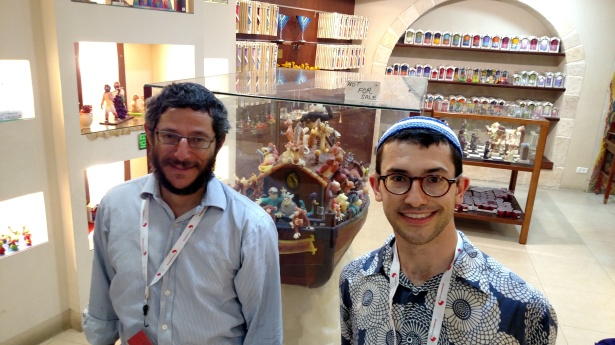
Noah and Gili posing in front of the Noah’s Ark candle (not for sale), and the chess set is behind Noah.
Returning the way I came, a parade entered the Ari synagogue: lots of young people wearing basketball-patterned כיפות. There was someone about to become a בר מצווה! I returned to the Olive Tree Courtyard, and found a nice view atop the courtyard, but no restaurants like what was suggested before the split-up. In the alley, I decided against the שניצל (schnitzel) stand that was there (not sure why), and later pushed past a pushy vendor of art. Eventually, I just got mint-chip ice cream at Taste of Tzfat, listened to the music, and Joshua Follick appeared. During our conversation, we talked about Jewish identity, particularly living in a place without much Judaism (i.e. Nebraska).
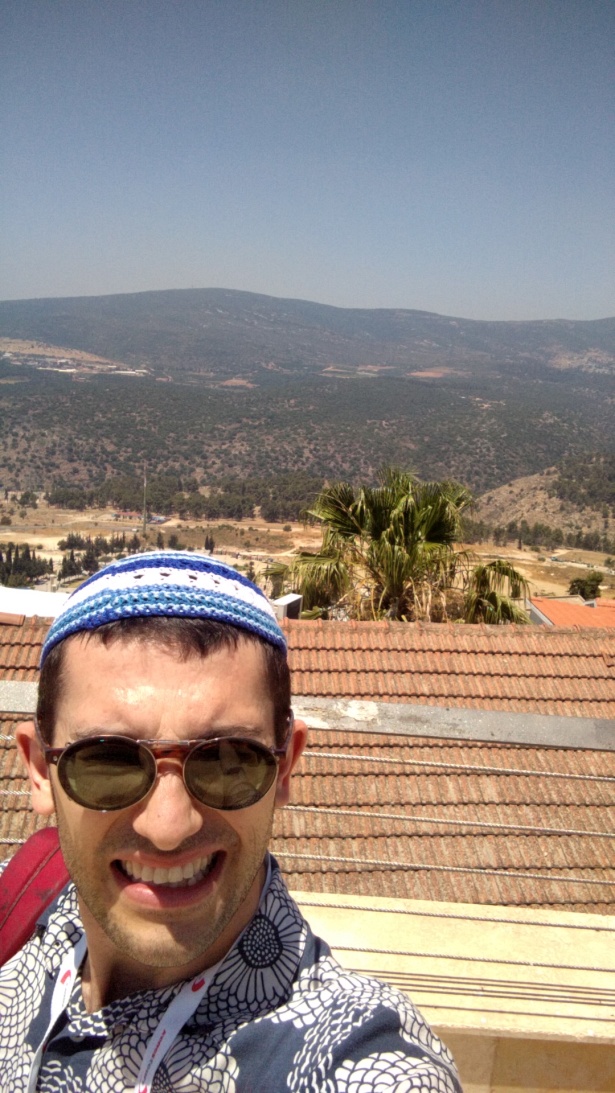
Close-up selfie with the mountains around צפת.
At 12:45, we were all on the bus and left צפת. On our way out, Gili pointed out הר מרון (Mt. Meron) and described the celebrations of ל”ג בעומר (Lag Ba’Omer) that occurs there. Over a million people celebrate up there with bonfires each year, and those fires are visible from space! As we continued to drive, we descended the hills of the גליל (Galilee) and got to the Jordan River! This river separates the Galilee from the Golan.
The rest of this drive was uneventful, though we did pass the entrance to the Gilabon trail. I didn’t get a snapshot, because it sneaked up on me. There was a bit of road construction, but nothing terrible. The drive took us past IDF bases, and we approached הר בנטל (Mt. Bental) just like six years ago. However we turned off to the 9-o’clock position of the rotary, instead of the 12-o’clock position, in order to go to מרום גולן (Merom Golan). These twin mountains are volcanic, but have not erupted in a long time.
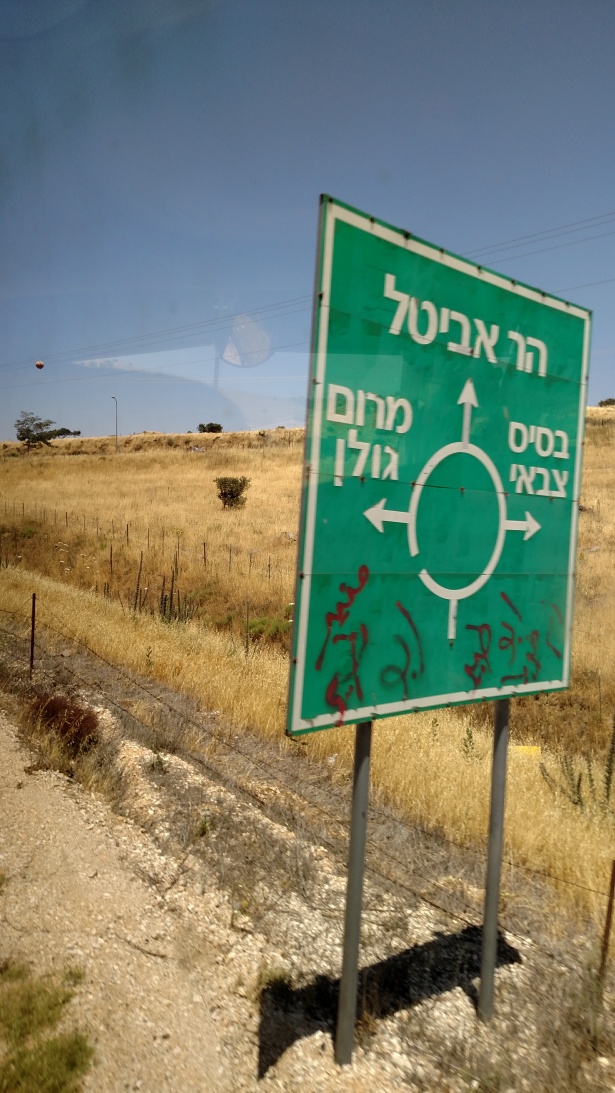
We refreshed, filled water bottles, and then went to the “Jeeps” (they’re a different brand) for a tour of the upper Golan Heights. We went over rough terrain (duh), past corn and banana fields, on surfaces that included roads AND dirt paths. Our driver used to give intelligence in the IDF. Ever since the end of מלחמת יום כפור (the Yom Kippur War), the Syrian border has been relatively calm on the Israel side. The armies dug ditches intended to make tanks stall.
Before climbing a hill, I saw a blue and yellow structure and joked that Sweden commissioned an IKEA store here. But at least we (i.e. the Corens, Feldmans, Weiss, and Harris) didn’t fall to pieces after an intentional STEEP drop (see the photo of the next jeep to do it)! The tour continued to the top of a hill, near an old Syrian bunker. We could see Syria from THIS back yard!
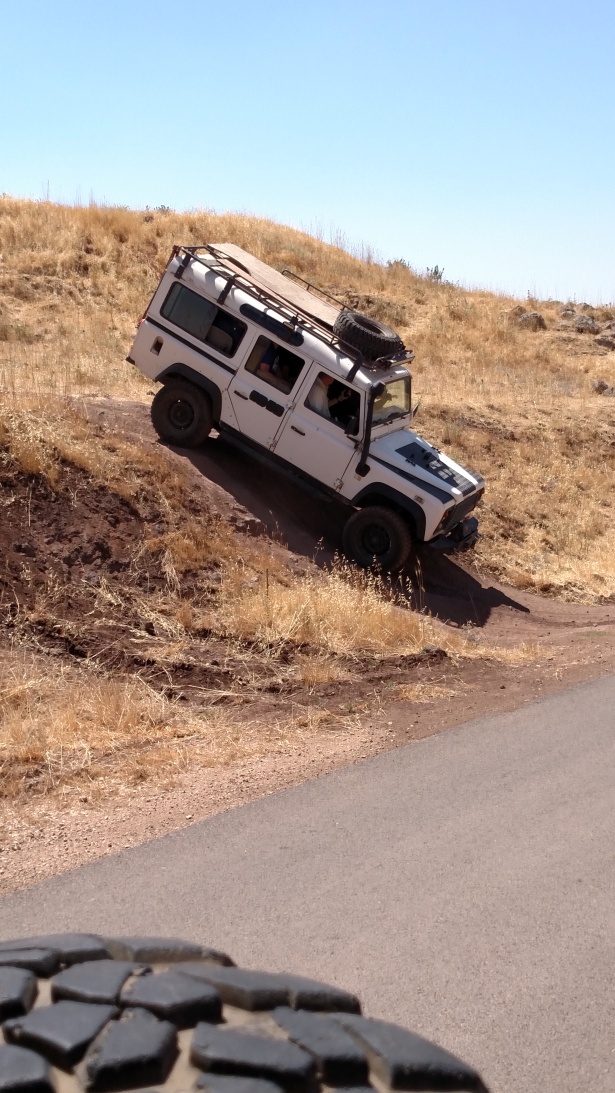
A fever pitch?
The drivers pointed out the United Nations vehicle driving on a road with rock shields. They named the UN as the “United Nothing”. Just like when my Birthright group was on הר בנטל six years ago, we could see the new and old cities of Quneitra, and also a plume of smoke from a battle or attack to the northeast of us. Ever since 1970, and possibly before, Syria’s population has been impoverished due to a 20% rate of unemployment. Fatwa was declared after Assad rose to power, and the civil war is very complicated. Right now, Israel does not accept Syrian refugees.

Just jotting down a few notes overlooking Syria… Photo credit Lori Feldman
Before leaving this lookout, we looked at the bunker, above and a bit inside. The former had a steep hill and the latter was pitch-black inside. We drove down the shield road, past banana “trees,” past cows, and past a UN station on the border. We also saw a camp of female IDF soldiers, obviously triggering the troublemakers of the jeep. The jeeps then took us in short order to עין זיוון (Ein Zivan).
At עין זיוון, the first stop was the De Karina chocolatier. We started by watching a video about the history of chocolate, which is a 3000-year-old idea. Chocolate didn’t come into solid form, however, until about 200-300 years ago — prior to that it was always in a liquid form. Fascinating! Karina was originally from Argentina, but made עלייה at some point. She is a third-generation chocolatier, and still does quality control at this place. After the movie ended, we entered the factory, but I decline the description of it in order to not get in trouble. Cameras were forbidden in this area, and I also didn’t take notes (intentionally). I will say that we did not see Karina — oh well!
In the next phase, we tasted a 62 percent dark chocolate, a savory-orange chocolate, a milk chocolate, and a dark chocolate with espresso. I liked them all, but especially the orange one. We then got to make our own items, including truffles, pralines, and a chocolate bar. We could roll in chocolate shavings, coconut, sprinkles, and a few other items. It was fun, and I made my bar in the shape of the word שוקולד (though the last two letters did not fit on the bar). It was fun!
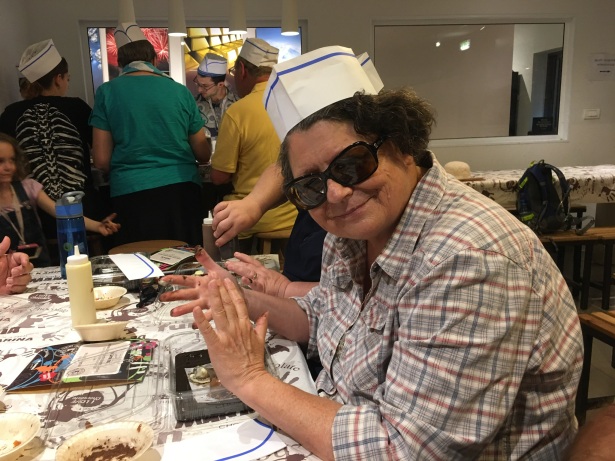
Jamie in the foreground, others in our bus (myself included) in the background, making chocolates (photo credit: Lori Feldman)
We then walked next door to Bahat Winery, and started by sampling three liqueurs: cherry, chocolate, and caramel (actually dulce de leche). I actually liked all of them, which is probably deeply surprising! The story of their winery started out as a hobby, but became a business ten years ago. All of the process is done by hand, so it is very much a microwinery. Their process is to crush and separate the grapes, then add yeast and ferment, and finally press into a wine bucket before going to age it in a cool dry place. At the end of the back room, Sydney and Ari got to label and cork empty souvenir bottles to take home.
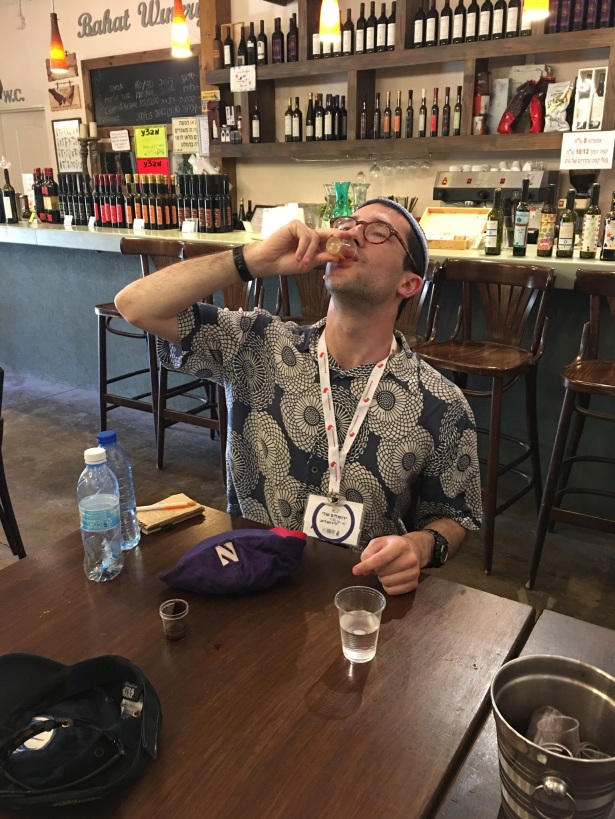
Is this even legal–Noah taking a shot of liqueur?! Photo credit: Lori Feldman.
Samples of cabernet sauvignon, shiraz, and port wines were available. I disliked the first, didn’t try the second, and wasn’t impressed by the third. I didn’t try the second due to the fact that I wanted to buy some chocolates to take home, despite the risk of them possibly melting in transit. We picked up our hand-made chocolates as well, boarded the bus, and then headed to עין גב (Ein Gev).
As we drove, we passed by קצרין (Katzrin), which obviously reminds me of the first time that I really enjoyed פלאפל when I had it in their mall’s food court. We also learnt about the eucalyptus trees. A Syrian evidently suggested planting these trees near the military bases to provide shade for the Syrian military. The person who suggested it was actually Eli Cohen, who was the famous Israeli spy executed for his work. Nevertheless, he was a Jewish and Israeli hero, and this story gave a different take on what I learnt down by the eucalyptus tree on the Gilabon trail.
The brown-squiggly signs, after I asked Gili, were revealed to label rivers, or נחלים (nahalim). A better English word to use is “wadi,” as a comparative definition. (Come to think of it, “wadi” is used as a translation to נחל when reading in the Pentateuch.) We also talked about the word תל (tel), which brought up James Michener, and perhaps some bad memories of Diff Block from my sophomore year of high school. Come to think of it, I should give The Source another chance, because I might take a new appreciation of it now, given my fascination with Israel and my stronger Jewish identity. Another thing of vocabulary that came out: בקר (bakar) is a cow, and בוקר (boker) is a cowboy (not just a morning). Gili also pointed out the ארבל cliff again as we could see it from across the lake.
At עין גב, we used the שירותים (restrooms) first, and had to wait for our boat. We sang some songs while waiting — some a-cappella, and some accompanied by Gili’s guitar. The boat eventually arrived, and it was playing Hebrew music and carrying an all-girls school or subset thereof. Once we boarded the ship, I started atop the bow, with the Follicks, Liz, and Jay.
Shortly after we got asea (alake?) Gilad popped in some music. It started with Eye of the Tiger, and Heat of the Moment, and then Highway to Hell. The triplets started off the dancing, but others weren’t really joining in. But then Hebrew music started, and the whole boat eventually joined in on dancing. We got some classics, some הדג נחש (Hadag Nahash), and more. I should ask Gilad for the playlist since I really enjoyed it. We also got some dusky photos, which are always nice to see. The song which particularly lodged in my head was תן לי מנגינה (Ten Li Mangina).
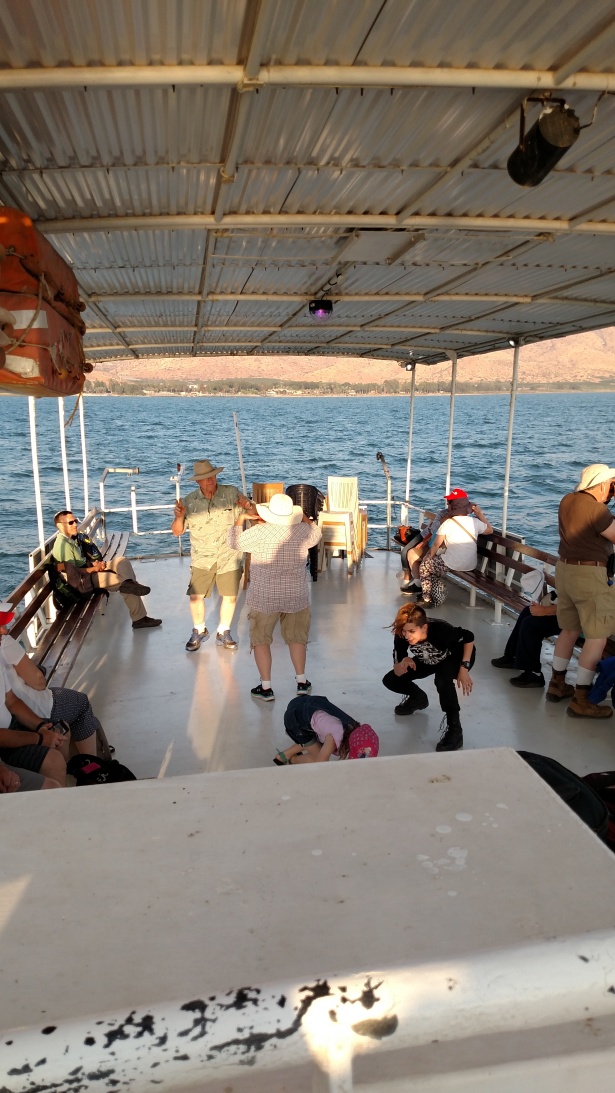
Dancers on the boat just before I joined in.
Alighting the boat, we had dinner at the Ein Gev Fish Restaurant. Naturally, we started with bread, salad, and חומוס (hummus). It was good, especially the fill-your-own-pita step. The fish came later, and my fried fish was basically pescado frito! Yes, with skin and bones! It still tasted good, but was a little challenging to eat. A few pescado eaters became surgeons as well, for effect! I don’t recall the conversations, but אלה חיים. The bentching was fun, and we could see the sunset too!
The driver tonight was אבשלום (Absalom) substituting for זכריה, since the latter was at a wedding tonight for a family member: מזל טוב (mazel tov)! We continued riding clockwise around the כנרת, seeing beaches, a college, קיבוץ האון (Kibbutz HaOn), and the dam bridge at דגניה (Degania). This led to Tiberias, and we got the story of Rabbi Meir, who shamed sinners, and his wife, who thought that repentance works for anyone. Near the Hotel Leonardo, there was an ancient synagogue discovered which forced the hotel to build its parking garage elsewhere!
The rest of the drive back to גינוסר was blah. Both Seth and I freshened up back at the hotel, when we had arrived around 21:44. I journaled a bit, and we both called for lights out since it was such a jam-packed day. Whew!
>> TO BE CONTINUED…
===========================================
(Dirty?) Thirty: 6 days
Nebraska Regional: 40 days
Semester Kickoff: 71 days


Great post, as usual! The biblical verse in Avraham’s art is “Ein od milvado” – “There is nothing but G-d” – Deuteronomy 4:35
In the R’Yosef Caro synagogue, the open scroll was for the hafatarah – books of the prophets read after the Torah portion. Sorry I didn’t explain that at the time!
LikeLike
Thanks for both of those clarifications. When I wrote the Hebrew in my notes, the last letter of “milvado” was too short to be a vav and too long to be a yud.
LikeLike